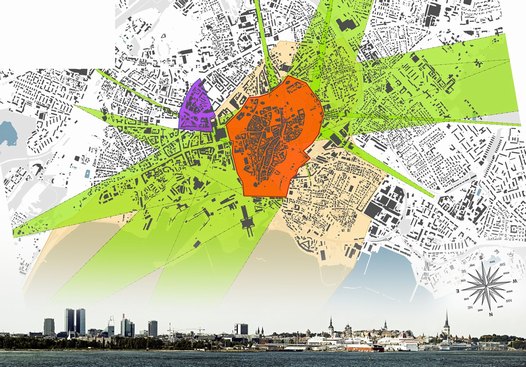
Map and photo of Tallinn´s famous silhouette with the 'old town' and the high-rise area Maakri Quarter ('Urban Hills') to the left. The high-rise in the centre of the photo is the 'Viru' hotel from 1972. Montage: Svein Gangsø, Osigraf
In 1997 the 'old town' of Tallinn was accepted onto the UNESCO world heritage sites list. The skyline of the old town is instantly recognisable.
At the beginning of the new millennium the building boom following the privatisation of real estate presented us with developers wanting to erect high-rise buildings. The only existing high-rise buildings in the city at that time were the "Viru" hotel built in the 1970s as a hallmark to the success of the Soviet economy and the Hotel "Olümpia" built for the Olympic Sailing Regatta in 1980.
The first high-rise of the "new era" was the SEB (formerly Ühispank) headquarters in 1999. Many different opinions were aired - among ordinary people and the decision-makers alike. The conservative wing in the debate proposed that central Tallinn should follow Helsinki, namely, by having a maximum limit of eight storey high buildings.
My argument is that little public opposition currently exists in respect of the building of high-rises per se. It is, rather, the need to address local traffic problems, the necessity of meeting insulation requirements and the design of high-quality public spaces that primarily concerns people. For urban planners it is of course obvious that some regulation is needed to cope with the pressure from developers to maximise the building potentials of every single plot.
In 2005 I was appointed head of the newly formed Division of Comprehensive Planning of the Urban Planning Department of Tallinn. One of our first tasks was to make theme-plans for the preservation of the milieu-valuable areas of central Tallinn and for the position of high-rise buildings in the city more generally. The plans were adopted by the City Council in 2008 and also by the cultural heritage protection authorities at municipal and state level.
High-rise buildings were now defined as exceeding 45 metres. There are eleven areas in Tallinn were such high-rise buildings may be erected. The maximum height varies from 60 to 130 metres with the exception of the Sitsi area where one building of 210 metres (approximately 70 floors) has been allowed.
The most suitable area to erect new high-rise buildings in Tallinn is in the Maakri Quarter. There are three reasons for this. Firstly it is in accordance with the protection requirements of the old town as a UNESCO world heritage site, secondly, it has an accessible location in the city centre and thirdly, some high-rise buildings already exist in the area. The maximum height in the Maakri Quarter is 130 metres and the degree of utilisation (maximum floor-area in relation to land-area per plot) is between 2.7:1 and 6.5:1.
All of the high-rise areas in Tallinn are situated beyond the protection and buffer zones of the old town world heritage site. The Maakri Quarter lies exactly just beyond the buffer zone to the south-east.
How has UNESCO reacted? On the 26th of March, 2010 a Technical Advisory Mission Report was issued. Their representative Ms. Margaretha Ehrström concluded:
"The strategies and objectives of the Thematic Plan are not in conformity with the preservation of the visual integrity of the World Heritage Site. There is a specific concern for the realisation of the Maakri area, which is situated on the border of the buffer zone. Plans have been approved for the construction of high-rise buildings of up to 130 metres here.
As the already realised high-rise buildings in this area already pose a threat to the visual integrity of Old Tallinn there should be no new construction of buildings of this extreme height. New constructions can be built at a lower height and more densely. The City Planning Office should also be part of the Management Committee of the World Heritage Site."
I agree that planning a dense quarter of high-rises has an additional level of urban complexity, and particularly in relation to the alteration of its skyline. The silhouette of the old town has acquired an almost symbolical value. It is, moreover, not just the artistic shape of the skyline, but also how it represents Tallinn as an historic city within a broader European context, that is important.
Adding a new "Urban Hill" – the Maakri Quarter – to Tallinn's skyline will not reduce the importance or magnificence of the silhouette of the old town, as I see it. The borders of the quarter are already defined by the existing high-rise structures. New buildings can be erected between these to complete the chaotic and broken shape of the skyline as it is at present. To get the best spatial composition an architectural contest should be arranged for the whole area.
In my view two "Urban Hills" could compliment each other expressing both the age and the vigour of the capital city of Estonia.
By Endrik Mänd, Chief Architect of Tallinn